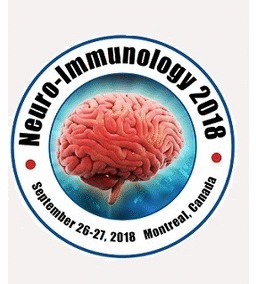International Conference on Neuroimmunology, Neurological disorders and Neurogenetics
Montreal, Canada

Ioanna A. Armata
Dr.Georges L-Dumont University Hospital Center and University of Moncton, Canada
Title: Micropeptides translated from polymorphic upstream open reading frames; lessons from Dopa-Responsive Dystonia
Biography
Biography: Ioanna A. Armata
Abstract
Approximately 50% of human transcripts harbor potential upstream translation start sites (uATGs) that initiate short open reading frames (uORFs) in the five untranslated region (5’ UTR) (Fig. 1A). Translation initiation at a uATG blocks a fraction of ribosomes from reaching the coding ATG (cATG) at the begging of the coding sequence (CDS). Thus, uATG-mediated repression ensures that cATG-protein expression is maintained at optimal levels. Interestingly, some uORFs encode short bioactive proteins with roles different than the role of the CDS-encoded protein. Single nucleotide polymorphisms (SNPs) that “introduce” uATGs in genes that are normally devoid of uATGs, repress CDS translation below optimal levels. About 17 different diseases are linked with SNP-introduced uATGs, among which a single neurological syndrome identified by our work. In particular, carriers of a GCH1 +142C>T SNP manifest Dopa-Responsive Dystonia (DRD), a neurological movement disorder of childhood onset. The GCH1 gene encodes GTP cyclohydrolase 1, a critical enzyme for dopamine (DA) biosynthesis. The +142C>T SNP introduces a uATG/uORF that initiates translation upstream of the GCH1 CDS, diminishing GCH1 protein levels and disrupting DA biosynthesis (Fig. 1B). Furthermore, the introduced uORF translates a 73aa-peptide that accumulates in the nucleus of cultured cells, - in contrast to the cytoplasmic GCH1 -, triggering cellular death. Cases of DRD caused by coding GCH1 mutations are successfully treated with L-Dopa, which compensates for reduced DA levels. Assuming 73aa-triggered death of the dopaminergic-neurons within the brain of 142T patients, L-dopa might be insufficient for these patients, and dystonia could progressively manifest to Parkinson’s Disease. Noteworthy, while translation of micropeptides from physiological uATGs/uORFs has been well demonstrated, only three studies have examined translation of microproteins from SNP-introduced uATGs/uORFs, and only the present study examined their impact on cellular homeostasis. Overall, our findings highlight the biological relevance of micropeptides translated from SNP introduced uATGs/uORFs.

